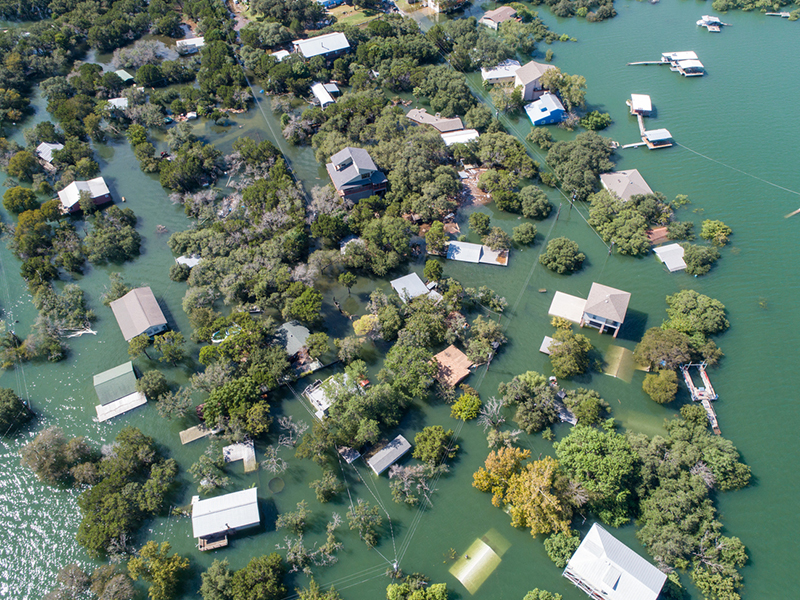
Watch for governments to transfer financial risk from natural disasters to insurers: Swiss Re
October 16, 2020 by Greg Meckbach

Print this page Share
There is growing awareness that governments can transfer the financial risk of natural disasters to both insurance and capital markets, a Swiss Re expert observes.
In Asia, Africa, the United States and Britain, there are examples of national and sub-national governments considering ways to share their financial risks — from weather catastrophes to earthquakes — with the private sector, said Tobias Meier, a Washington, D.C.-based key account manager with Swiss Re’s public sector solutions team.
About 70% of economic losses from natural catastrophes around world are uninsured, Meier said Oct. 14 during Risks and Opportunities for the Capital Markets, a panel held during a virtual webinar hosted by CatIQ. Uninsured losses are growing faster than insured portion, Meier said.
“The question is, who absorbs these uninsured costs? The answer to that, frankly, is you and I as taxpayers.”
For uninsured natural catastrophe property losses, the public sector carries costs such as reconstruction and for emergency programs. So there is a growing trend of public sector entities considering options to transfer those risks to insurance, reinsurance or capital markets, said Meier.
He pointed to the United States National Flood Insurance Program as an example, because it buys reinsurance and transfers some risk to capital markets.
Catastrophe bonds and sidecars are examples of capital market instruments that can be used to help cover insured losses.
“There is no single model that fits all,” said Meier. “In some cases, the central government is buying insurance. In other cases, the government might incentivize homeowners or businesses or individuals to do so. And perhaps [the government will] subsidize those premiums, or simply facilitate the process and set up a platform that allows individual insurers to pool their risk.”
Meier’s panel was part of Financial Sector on Catastrophes & Climate Change, one of the CatIQ Connect series of quarterly talks. The next talk is scheduled Dec. 3.
During the capital markets panel Oct. 14, Meier noted that the states of Utah, California and Florida are transferring some of their natural catastrophe risks to insurance markets.
“Buying insurance – and I am using the term generically here to comprise both insurance/reinsurance and capital market instruments – is always part of a bigger plan,” Meier said. “It is not that people make a decision overnight to buy insurance all of a sudden. Usually these are very much-informed strategies that are comprised of quantifying the risk, of prioritizing it, or slicing and dicing it, and sometimes putting in the necessary laws that are required for budgetary appropriation processes and so forth. At the end of that outcome is an actual transaction whereby risk is transferred to the market.”
Separately, in a paper released in 2019, the Insurance Bureau of Canada proposed three possible options to address insurance for properties at high risk of flood. One option, a public-private high-risk pool, could get capital from ceded premiums, contributions by government, levies applied to homeowners, and levies applied to property taxes.
For its part, the Insurance Brokers Association of Canada has called for a partnership between the public and private sectors to make flood insurance available and affordable to all homeowners who need it.
Residential overland flood coverage was generally not available in Canada until 2015, but even now, coverage is unavailable or unaffordable to some because they are considered high-risk by the insurers.
The federal government proposed in early 2014 to consult with the insurance industry, the provinces, and the territories to explore options for a national approach to residential flood insurance.
Today, Canada does not have a program similar in concept to either the U.S. NFIP or Britain’s Flood Re.
In her throne speech Sept. 23, Governor General Julie Payette noted the federal government is promising money to reduce the impact of climate-related disasters like floods and wildfires to make communities safer and more resilient.
“Flood was confirmed to be a continuing priority for the government moving forward,” Craig Stewart, vice president of federal affairs for the Insurance Bureau of Canada, told Canadian Underwriter in a separate interview. “We expect that there are going to be developments this fall. There is a fair amount of preparatory work and ongoing dialogue with the provinces under way and so that work is all continuing,”
Feature image via iStock.com/RoschetzkyIstockPhoto
Have your say: